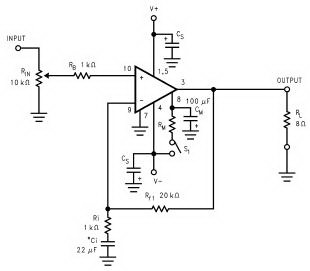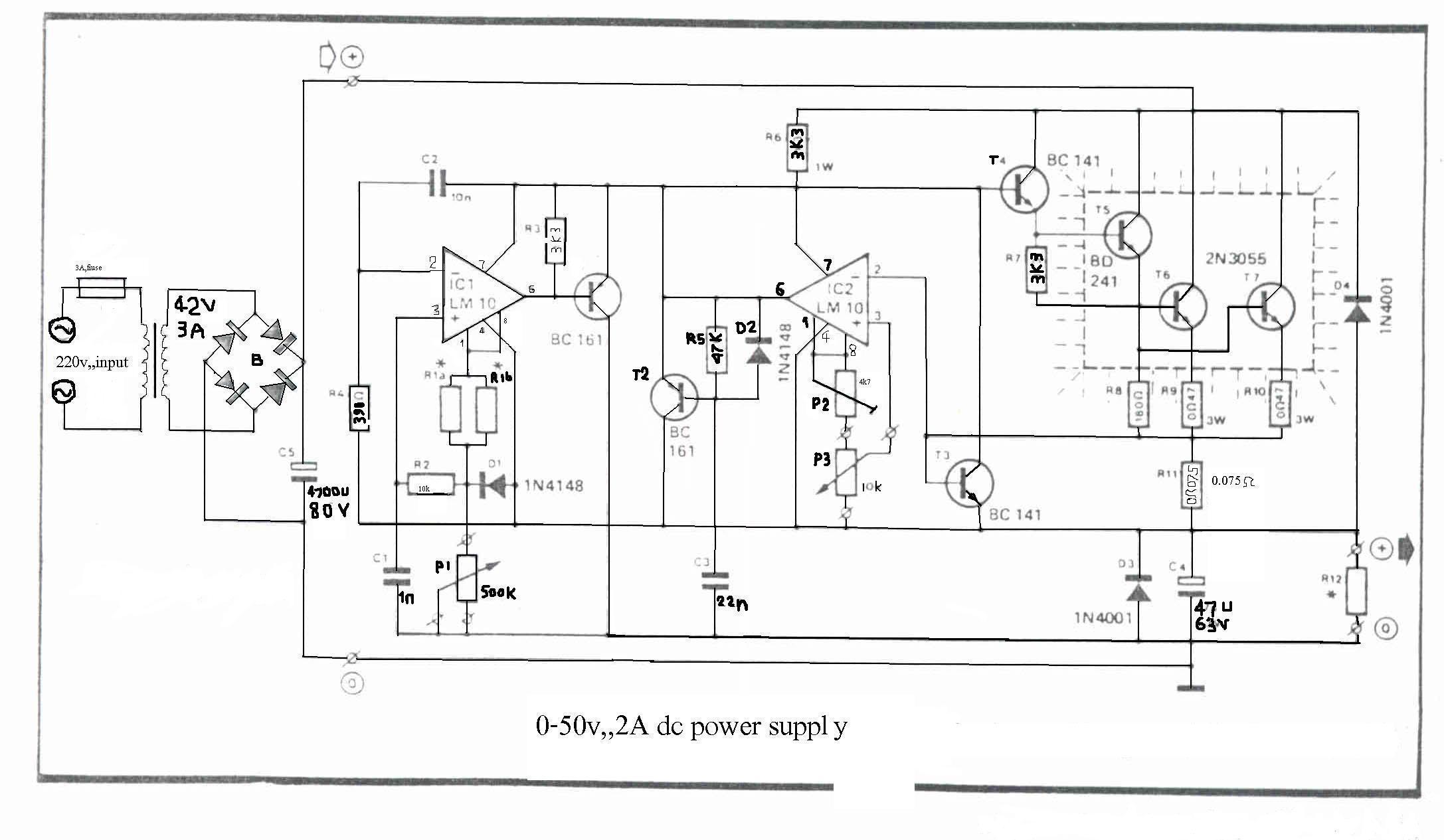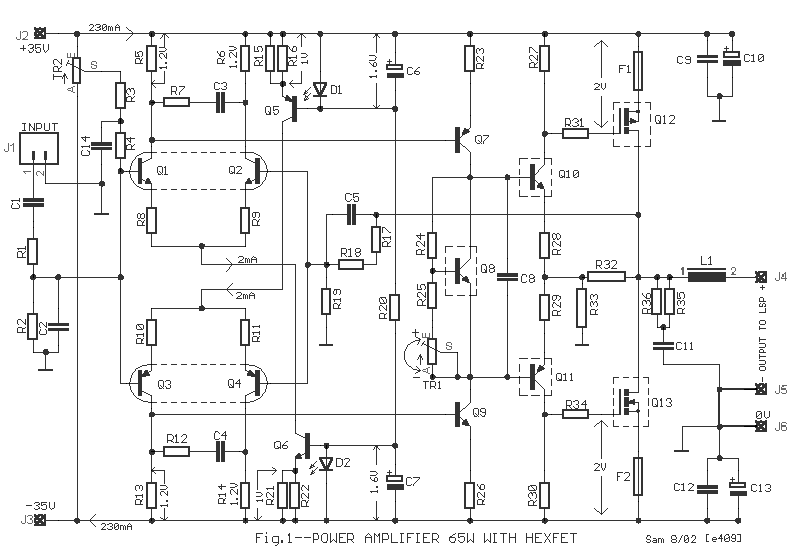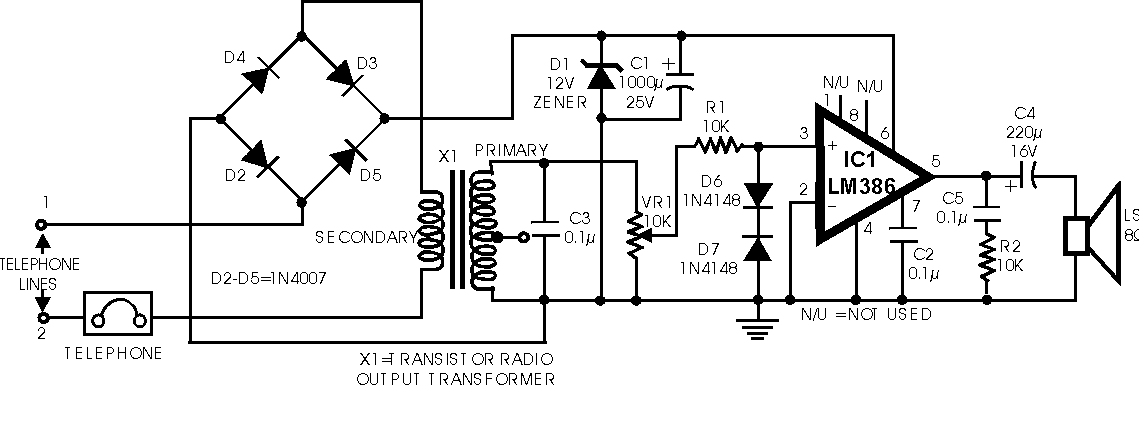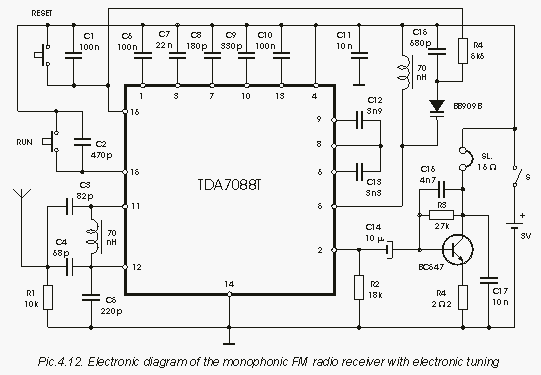
Power amplifier using transistors
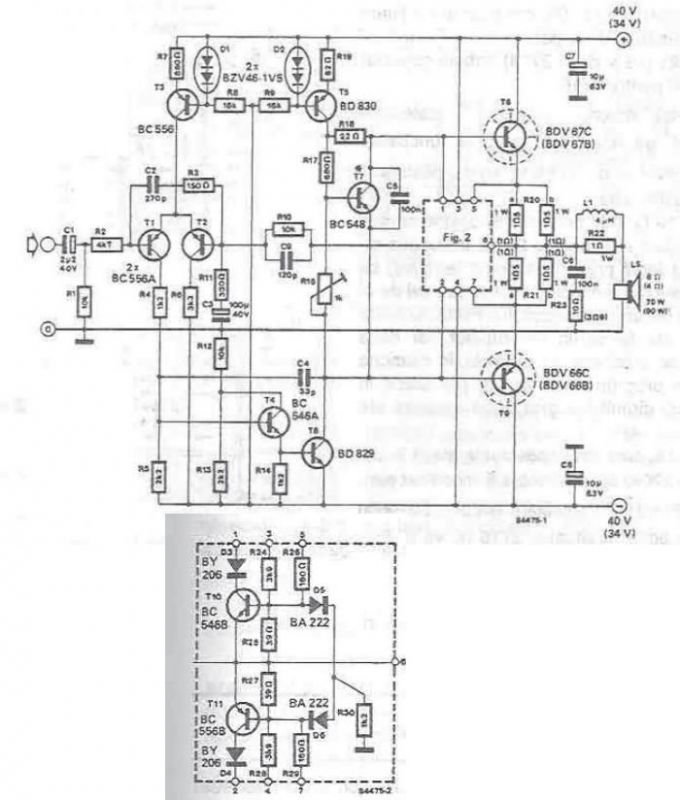
A high-power audio amplifier can be designed using power transistors and other common electronic components, capable of delivering a maximum output power of 90W. When using the specified component values, it can drive speakers with a 4-ohm impedance, resulting in an output power of approximately 90 watts. The input signal is fed into transistor T1, while the response is monitored via transistor T2. The current through the differential stage is maintained at a constant 1 mA by a current source connected through T3. The input signal for transistors T4 and T8 is derived from the collector of T1, and in conjunction with current source T5, forms a Class A control stage for the power transistors. The current through this control stage is relatively small, around 7 mA, since transistors T6 and T9 are configured as Darlington power transistors. When using a 4-ohm load, modifications to the protection circuit are necessary. The resistor values R24 and R28 should be set to 3.9k ohms, while R26 and R28 should be adjusted to 220 ohms. Additionally, diodes D5, D6, and resistor R30 should be removed. The rectified voltage for a 70W output with an 8-ohm load is approximately ±40V, which corresponds to about ±47V under no load conditions. For a 4-ohm load, the voltage values are approximately ±34V and ±40V, respectively.
The high-power audio amplifier circuit is designed to deliver robust audio performance while ensuring thermal stability and protection against overloads. The circuit begins with the input stage, where the audio signal is introduced to transistor T1. This transistor operates as a common-emitter amplifier, providing initial amplification of the audio signal. The output from T1 is then fed to T2, which serves as a feedback mechanism to stabilize the amplifier's performance.
The differential stage, consisting of T3, maintains a constant current of 1 mA, ensuring that the amplifier operates within its optimal range. This constant current is crucial for maintaining linearity and minimizing distortion in the amplified audio signal. The control stage, formed by T4, T5, and T8, operates in Class A mode, providing a clean and linear amplification of the audio input. The relatively low current of 7 mA through this stage ensures that the power transistors T6 and T9, configured as Darlington pairs, can deliver high output power efficiently.
To accommodate a 4-ohm load, careful adjustments to the protection circuit are necessary. The specified resistor values (R24 and R28 at 3.9k ohms, and R26 and R28 at 220 ohms) ensure that the amplifier remains stable under varying loads. The removal of diodes D5, D6, and resistor R30 simplifies the protection circuitry while maintaining functionality.
The power supply for the amplifier is designed to deliver a rectified voltage of ±40V for an 8-ohm load, which is sufficient for achieving a maximum output of 70W. Under no load conditions, this voltage can rise to approximately ±47V, providing headroom for dynamic audio peaks. For operation with a 4-ohm load, the voltage levels adjust to ±34V and ±40V, ensuring the amplifier can still deliver high power without distortion or clipping.
In summary, the described high-power audio amplifier circuit effectively combines various electronic components to achieve a powerful and efficient audio amplification solution, suitable for driving low-impedance speakers while maintaining audio fidelity and system protection.Using some power transistors and some other common electronic components, can be designed a high power audio amplifier capable to provide a maximum output power of 90W. If the component values in parentheses are used can be connected speakers with 4 ohm impedance, in which case the amplifier maximum output power will be around 90 watts.
The input signal is brought to the transistor T1 and the reaction is taken on the basis of T2. Current through deferential stage is kept constant at 1 mA current source through the action of T3. The input signal for T4/T8 transistor is taken from the T1`s collector in combination with current source T5 forms a control stage class A for power transistors. Current through control stage is quite small (about 7 mA) as T6 and T9 are Darlington power transistors.
Protection circuit from Fig. 2 must also be changed when using a 4 ohm load. R24 and R28 values are then 3k9, R26 and R28 are 220 ohms, and D5, D6 and R30 are all eliminated. Rectified voltage for 70 W / 8 ohms version is ± 40 V to be in load, no load, this corresponds to about ± 47 V. At 4 ohms, these values are ± 34, respectively, ± 40 V. 🔗 External reference
The high-power audio amplifier circuit is designed to deliver robust audio performance while ensuring thermal stability and protection against overloads. The circuit begins with the input stage, where the audio signal is introduced to transistor T1. This transistor operates as a common-emitter amplifier, providing initial amplification of the audio signal. The output from T1 is then fed to T2, which serves as a feedback mechanism to stabilize the amplifier's performance.
The differential stage, consisting of T3, maintains a constant current of 1 mA, ensuring that the amplifier operates within its optimal range. This constant current is crucial for maintaining linearity and minimizing distortion in the amplified audio signal. The control stage, formed by T4, T5, and T8, operates in Class A mode, providing a clean and linear amplification of the audio input. The relatively low current of 7 mA through this stage ensures that the power transistors T6 and T9, configured as Darlington pairs, can deliver high output power efficiently.
To accommodate a 4-ohm load, careful adjustments to the protection circuit are necessary. The specified resistor values (R24 and R28 at 3.9k ohms, and R26 and R28 at 220 ohms) ensure that the amplifier remains stable under varying loads. The removal of diodes D5, D6, and resistor R30 simplifies the protection circuitry while maintaining functionality.
The power supply for the amplifier is designed to deliver a rectified voltage of ±40V for an 8-ohm load, which is sufficient for achieving a maximum output of 70W. Under no load conditions, this voltage can rise to approximately ±47V, providing headroom for dynamic audio peaks. For operation with a 4-ohm load, the voltage levels adjust to ±34V and ±40V, ensuring the amplifier can still deliver high power without distortion or clipping.
In summary, the described high-power audio amplifier circuit effectively combines various electronic components to achieve a powerful and efficient audio amplification solution, suitable for driving low-impedance speakers while maintaining audio fidelity and system protection.Using some power transistors and some other common electronic components, can be designed a high power audio amplifier capable to provide a maximum output power of 90W. If the component values in parentheses are used can be connected speakers with 4 ohm impedance, in which case the amplifier maximum output power will be around 90 watts.
The input signal is brought to the transistor T1 and the reaction is taken on the basis of T2. Current through deferential stage is kept constant at 1 mA current source through the action of T3. The input signal for T4/T8 transistor is taken from the T1`s collector in combination with current source T5 forms a control stage class A for power transistors. Current through control stage is quite small (about 7 mA) as T6 and T9 are Darlington power transistors.
Protection circuit from Fig. 2 must also be changed when using a 4 ohm load. R24 and R28 values are then 3k9, R26 and R28 are 220 ohms, and D5, D6 and R30 are all eliminated. Rectified voltage for 70 W / 8 ohms version is ± 40 V to be in load, no load, this corresponds to about ± 47 V. At 4 ohms, these values are ± 34, respectively, ± 40 V. 🔗 External reference
